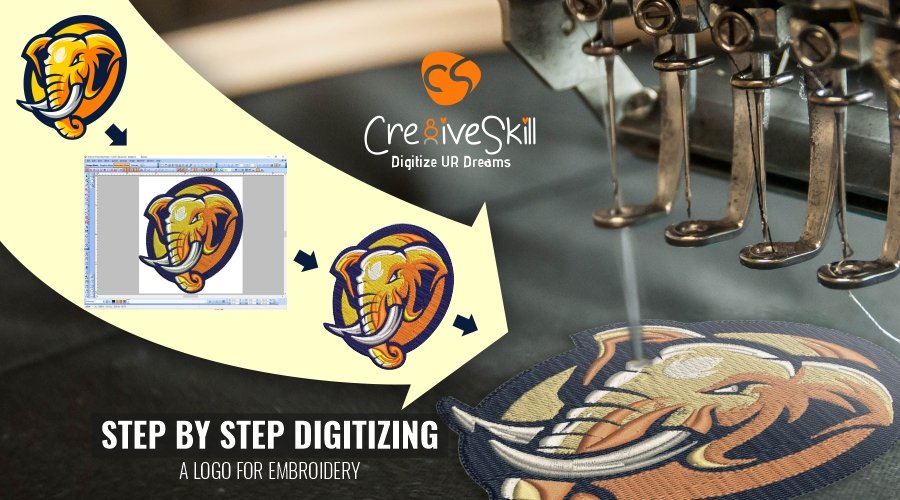Streamlining the Art of Needlework Digitizing: Step-by-Step Overview
As technology proceeds to advance, the digitization procedure has become a lot more available, permitting fanatics to bring their complex designs to life with simplicity. In this overview, we will untangle the complexities of needlework digitizing, breaking down each step methodically to enhance the process and equip both newbies and seasoned embroiderers alike.
Recognizing Embroidery Digitizing Software Application
Embroidery digitizing software functions as an essential device for changing elaborate styles right into digital layouts compatible with needlework equipments, helping with exact sewing and customization. This specific software program permits individuals to import numerous image file styles, such as JPG or PNG, and transform them right into needlework machine-readable formats like DST, EXP, or PES - Digitizing for Embroidery. By using functions like stitch editing and enhancing, underlay choices, and string shade selection, digitizing software application allows customers to control every facet of the style procedure
Moreover, advanced needlework digitizing software program provides devices for developing intricate designs, adjusting stitch density, and incorporating detailed information. Users can also preview the style before sewing it out, making certain precision and decreasing mistakes. Furthermore, several software application programs provide automatic attributes that assist simplify the digitizing process, saving time and effort.
Understanding the abilities of needlework digitizing software program is important for achieving premium results in embroidery projects. By mastering this device, needlework enthusiasts and specialists can release their imagination and bring elaborate designs to life with accuracy and performance.

Selecting the Right Design File
After acquainting on your own with the capacities of needlework digitizing software application, the following critical action in the procedure is picking the appropriate layout data for your job. Digitizing for Embroidery. When selecting a design documents for embroidery digitizing, it's vital to consider the intricacy of the style, the size of the last item, and the kind of fabric you will certainly be working with
For elaborate designs with great details, a high-resolution image or vector documents is suggested to guarantee that the embroidery maker can precisely recreate the layout. Furthermore, the size of the end product plays a significant duty in choosing the right layout data. Larger layouts may call for higher resolution files to preserve clarity and sharpness.
Additionally, the sort of material you will certainly be embroidering on influences the selection of style file. Various textiles may find out call for adjustments in the style documents to ensure that the stitches are appropriately straightened and the layout appears as planned. By thoroughly choosing the appropriate design file based upon these variables, you can establish on your own up for an effective needlework digitizing procedure.
Digitizing Devices and Techniques
Using specialized software application and accuracy strategies, digitizing tools are vital in transforming complex styles right into embroidery-ready files. Embroidery digitizing software, such as Wilcom, Hatch, or Embrilliance, provides the needed system to transform artwork into stitch data. These programs use attributes like stitch editing and enhancing, padding choices, and text devices to make sure the style equates flawlessly onto textile.
Among the vital strategies in digitizing is producing a clear course for the needlework device to adhere to. This involves digitizing each element of the layout with precision, establishing stitch kinds, thickness, and instructions. By utilizing tools like digitizing tablets or software-specific plugins, embroiderers can achieve a high degree of precision in their digitized styles.
Moreover, understanding the art of rug stitching is essential for producing quality needlework. Underlay sewing supports the fabric and creates a foundation for the design, ensuring that the end product is both visually appealing and long-lasting. By recognizing these digitizing devices and techniques, embroiderers can elevate their craft and bring detailed styles to life with precision and performance.
Tailoring Stitch Types and Directions
The option of stitch types can dramatically affect the total appearance and appearance of the embroidered style. By purposefully combining these stitch types, embroiderers can attain deepness and dimension in their styles.
Moreover, the direction of stitches plays a vital duty in boosting the aesthetic allure of the last needlework. By trying out with various stitch angles and patterns, embroiderers can bring their layouts to life with impressive information and details.
Screening and Refining Your Digitized Design
To ensure the accuracy and quality of your digitized design, extensive testing and refinement are important steps in the embroidery digitizing process. Once you have finished the digitization of your layout, it navigate here is critical to examine it prior to waging the actual embroidery. Examining allows you to identify any kind of prospective problems such as thread breaks, sew thickness issues, or design distortions that may affect the outcome.

After testing, it is essential to refine your digitized layout based upon the comments from the examination sew-out. This may entail tweaking sew settings, readjusting thickness, or making changes to the total layout to accomplish the desired end result. By repeating via testing and refinement, you can tweak your digitized design to perfection prior to moving on with the real embroidery procedure.
Final Thought
In conclusion, understanding the art of embroidery digitizing requires a comprehensive understanding of the software, choosing the best layout data, utilizing digitizing devices and techniques, tailoring stitch types and instructions, and testing and improving the digitized design. By adhering to these steps, embroiderers can streamline the digitizing her response procedure and create high-quality stitched styles with precision and performance.
Comments on “Dependable Digitizing for Embroidery: Trusted by Professionals”